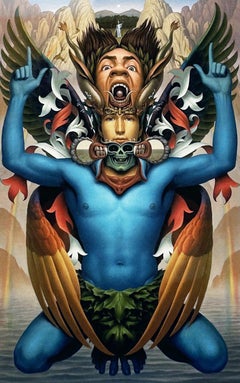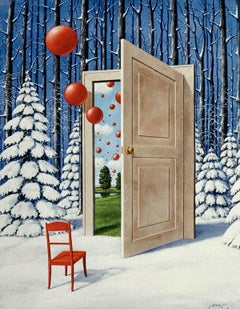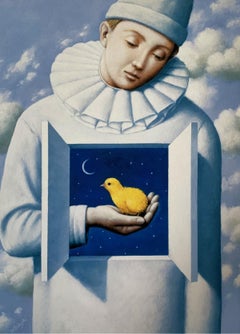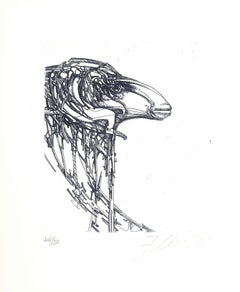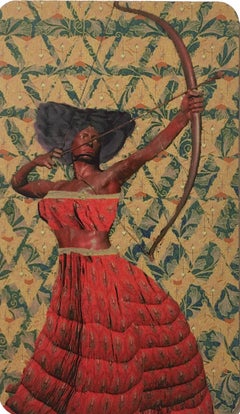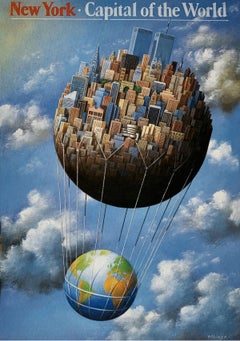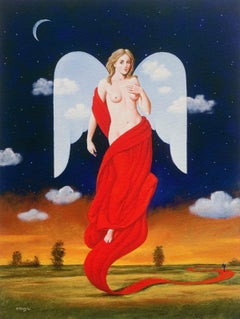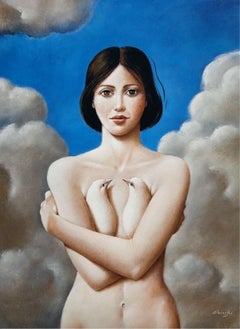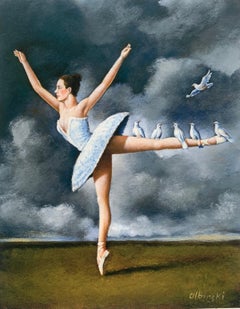Surreal And Print
21st Century and Contemporary Contemporary Figurative Prints
Giclée
2010s Surrealist Figurative Prints
Paper, Color
2010s Surrealist Figurative Prints
Paper, Color
1980s Contemporary Animal Prints
Screen
2010s Contemporary Figurative Prints
Digital
2010s Surrealist Figurative Prints
Paper, Color
2010s Surrealist Figurative Prints
Paper, Color
2010s Surrealist Figurative Prints
Paper, Color
2010s Surrealist Figurative Prints
Paper, Color
2010s Surrealist Figurative Prints
Paper, Color
2010s Surrealist Figurative Prints
Paper, Color
2010s Surrealist Figurative Prints
Paper, Color
2010s Contemporary Figurative Prints
Digital, Archival Paper, Archival Pigment
2010s Surrealist Figurative Prints
Paper, Color
2010s Surrealist Figurative Prints
Paper, Color
2010s Surrealist Figurative Prints
Paper, Color
2010s Surrealist Figurative Prints
Paper, Color
2010s Contemporary Figurative Prints
Drypoint, Paper
1980s Pop Art Nude Prints
Woodcut
2010s Surrealist Figurative Prints
Paper, Color
21st Century and Contemporary Contemporary Animal Prints
Color, Archival Paper
2010s Contemporary Portrait Prints
Metal
2010s Contemporary Figurative Prints
Paper, Ink, Archival Ink, Aquatint
2010s Contemporary Figurative Prints
Drypoint, Paper
2010s Contemporary Figurative Prints
Drypoint, Paper
2010s Contemporary Figurative Prints
Etching, Paper
2010s Contemporary Figurative Prints
Etching, Paper
2010s Contemporary Figurative Prints
Etching, Paper
Early 2000s Contemporary Landscape Prints
Cardboard, Monotype
1930s Surrealist Prints and Multiples
Lithograph
2010s Art Deco Still-life Prints
Photographic Film, Archival Ink, Photographic Paper, C Print, Digital, G...
2010s Contemporary Figurative Prints
Cardboard, Monotype
2010s Contemporary Figurative Prints
Digital
2010s Contemporary Figurative Prints
Digital
2010s Contemporary Figurative Prints
Digital
1980s Pop Art Nude Prints
Drypoint
1980s Abstract Prints
Etching, Aquatint, Screen
1970s Surrealist Abstract Prints
Mixed Media, Lithograph
2010s Contemporary Figurative Prints
Digital
2010s Contemporary Figurative Prints
Digital
2010s Contemporary Figurative Prints
Digital
2010s Contemporary Figurative Prints
Digital
2010s Contemporary Figurative Prints
Digital
2010s Contemporary Portrait Prints
Metal
21st Century and Contemporary Contemporary Figurative Prints
Giclée
2010s Contemporary Figurative Prints
Digital
2010s Surrealist Portrait Prints
Metal
Natasha LelencoFloral Crown and Snail: Surreal Portrait with Whimsical Details. Lim. Ed. 25/25, 2024
1970s Surrealist Abstract Prints
Paper, Ink, Etching
1970s Surrealist Landscape Prints
Screen
1970s Surrealist Landscape Prints
Screen
20th Century Modern Abstract Prints
Woodcut
1980s Surrealist Figurative Prints
Etching, Paper
1970s Surrealist Landscape Prints
Screen
Early 20th Century Modern Figurative Prints
Pencil
1940s Modern Portrait Prints
Etching
1980s Contemporary Figurative Prints
Lithograph
1960s Surrealist Figurative Prints
Lithograph
1970s Surrealist Animal Prints
Lithograph
1970s Abstract Expressionist Abstract Prints
Lithograph
2010s Surrealist Figurative Prints
Lithograph, Offset
- 1
Surreal And Print For Sale on 1stDibs
How Much is a Surreal And Print?
- What is figurative Surrealism?2 Answers1stDibs ExpertSeptember 25, 2019
In figurative Surrealist works, natural forms — humans, animals, objects — are depicted, although they are generally dislocated or mutated.
1stDibs ExpertSeptember 25, 2019The two types of Surrealism are abstract and figurative.
- 1stDibs ExpertSeptember 25, 2019
Surrealism is characterized by symbolism, unexpected combinations and non sequiturs.
- 1stDibs ExpertSeptember 25, 2019
Salvador Dalí’s painting The Persistence of Memory,1931, is a quintessential example of Surrealism.
- Where did Surrealism start?1 Answer1stDibs ExpertAugust 20, 2024Surrealism started in Paris, according to numerous historians. It was there that André Breton published the Manifesto of Surrealism in 1924, and the first collective exhibition of Surrealist painting was held at the Galerie Pierre in November of 1925. Surrealist art features dreamlike and uncanny imagery guided by a variety of techniques, such as automatic drawing, which can be likened to a stream of consciousness, to channel psychological experiences. Although Surrealism was a groundbreaking approach for European art, its practitioners were inspired by Indigenous art and ancient mysticism to re-envision how sculptures, paintings, prints, performance art and more could respond to the unsettled world around them. On 1stDibs, shop a diverse assortment of Surrealist art.
- 1stDibs ExpertOctober 15, 2024Representational Surrealism is the term for art that uses realistic imagery to depict the workings of the unconscious mind. Salvador Dalí's paintings The Persistence of Memory and Dream Caused by the Flight of a Bee Around a Pomegranate a Second Before Awakening are examples of this type of Surrealist art. The opposite of Representational Surrealism is Abstract Surrealism. Instead of incorporating real objects, artists who worked in this style featured non-representational shapes, colors and imagined forms in their works. Some examples of Abstract Surrealism include Jean Arp's Danger of Death and Torn-Up Woodcut. On 1stDibs, shop a large collection of Surrealist art.
- When did Surrealism start?1 Answer1stDibs ExpertApril 26, 2024Surrealism started in the 1920s, following the conclusion of World War I. Surrealist artists were informed by the Dada movement, which originated in 1916 in Zurich and embraced absurdity over the logic that had propelled modernity into violence. Some of the Surrealists had witnessed this firsthand, such as Max Ernst, who served in the trenches during World War I, and Salvador Dalí, whose otherworldly paintings and other work responded to the dawning civil war in Spain. On 1stDibs, explore a range of Surrealist art.
- Who is the father of Surrealism?1 Answer1stDibs ExpertSeptember 25, 2019
The father of Surrealism is Salvador Dalí.
- 1stDibs ExpertOctober 7, 2024The grandfather of Surrealism was Giuseppe Arcimboldo. Active during the Italian Renaissance, the painter predated Surrealism by 400 years, but his imaginative portraits inspired Salvador Dalí and other Surrealists. He was particularly well-known for substituting fruits, vegetables and other foods for the facial features of his subjects. Some of his most famous paintings include Vertumnus, The Librarian, Summer and The Jurist. On 1stDibs, shop a wide range of Surrealist art.
- 1stDibs ExpertOctober 15, 2024The Surreal artist Salvador is Salvador Dalí. Instantly recognizable by his waxed, upturned mustache, the flamboyant Dalí was one of modern art’s most distinctive figures. He remains an icon of the 20th-century avant-garde Surrealist movement. The dreamlike images he painted were drawn from the depths of the unconscious. He also brought this uncanny eye to sculptures, prints, fashion and film, with collaborators including Luis Buñuel and Alfred Hitchcock. Some of his most famous works include The Persistence of Memory, The Great Masturbator and Dream Caused by the Flight of a Bee Around a Pomegranate a Second Before Awakening. On 1stDibs, find an assortment of Salvador Dalí art.
- 1stDibs ExpertNovember 20, 2024In art, the definition of Surrealism is a movement that emerged in the 1920s and was defined by dreamlike and uncanny imagery. It was often guided by a variety of techniques, such as automatic drawing, to channel psychological experiences. In the wake of World War I’s ravaging of Europe, artists delved into the unconscious mind to confront and grapple with this reality. Poet and critic André Breton, a leader of the Surrealist movement who authored the 1924 Surrealist Manifesto, called this approach “a violent reaction against the impoverishment and sterility of thought processes that resulted from centuries of rationalism.” Artists who produced Surrealist art included Max Ernst, Salvador Dalí, Man Ray, Joan Miró, René Magritte, Yves Tanguy, Frida Kahlo and Meret Oppenheim. On 1stDibs, shop a selection of Surrealist art.
- 1stDibs ExpertAugust 29, 2024What André Breton did for Surrealism was help establish its principles. In 1924, he authored the Surrealist Manifesto, which clearly defined the movement. He also served as a leader of Surrealism, and his writings and artworks influenced other Surrealist artists, such as René Magritte and Joan Miró. Shop a diverse assortment of André Breton art on 1stDibs.
- 1stDibs ExpertOctober 7, 2024The main focus of Surrealism was delving into the unconscious mind to confront and grapple with the horrors and uncertainty of post-World War I Europe. Poet and critic André Breton, a leader of the Surrealist movement who authored the 1924 Surrealist Manifesto, called this approach “a violent reaction against the impoverishment and sterility of thought processes that resulted from centuries of rationalism.” Surrealist art emerged in the 1920s with dreamlike and uncanny imagery guided by a variety of techniques, such as automatic drawing, which can be likened to a stream of consciousness, to channel psychological experiences. Find a large selection of Surrealist art on 1stDibs.
- 1stDibs ExpertSeptember 25, 2019
Surrealism is classical in orientation while Abstract Expressionism is romantic in orientation.
- 1stDibs ExpertSeptember 25, 2019
The main idea behind Surrealism is to enable subconscious creativity.
- 1stDibs ExpertOctober 15, 2024Max Ernst used Surrealism to process the traumas he experienced during World War I. His early works consisted largely of collages, which allowed him to represent the shards, rubble and explosions from his wartime experience. In 1922, Ernst moved to France, where he soon became affiliated with Surrealism, the avant-garde art movement taking shape in Paris. Alongside Man Ray, Joan Miró and others, Ernst was among the first visual artists to experiment with the imagery and techniques that became associated with Surrealist art. Ernst’s greatest contribution to the Surrealist movement is often considered his invention of frottage, wherein an artist rubs a pencil or crayon over a paper atop a textured surface, and later grattage, where a similar technique is applied with paint. Both methods showcase Ernst’s fascination with the unconscious and serendipitous elements of artistic creation, a theme that connected the Dadaists and the Surrealists. Explore a range of Max Ernst art on 1stDibs.
- 1stDibs ExpertOctober 15, 2024Most experts state that Meret Oppenheim was part of Surrealism, not Dada. Oppenheim moved to Paris to attend art school in 1932. There, she met sculptor Alberto Giacometti, who introduced her to Man Ray, Max Ernst and André Breton, considered the founder of the Surrealist movement. Within a year, Oppenheim was exhibiting her paintings with the Surrealists, the first female artist to do so. One of her most famous works is the 1936 Object, the enduringly disconcerting fur-covered teacup, saucer and spoon. On 1stDibs, shop a variety of Meret Oppenheim art and furniture.
- 1stDibs ExpertNovember 20, 2024Max Ernst contributed to Surrealism by pushing the boundaries of the movement with his unconventional methods of printmaking, drawing and collage. He invented frottage (French for “rubbing”), wherein an artist rubs a pencil or crayon over a paper atop a textured surface, and later grattage (French for “scraping”), where a similar technique is applied with paint. Both methods showcase Ernst’s fascination with the unconscious and serendipitous elements of artistic creation, a theme that resonated with the Dadaists and the Surrealists. Ernst had deep knowledge of psychoanalysis and Sigmund Freud’s dream theories, which were big influences on Surrealists. He was among the first Surrealists to use Freud’s work to examine his own creative impulses. He also published a series of books of his collages, all of which were deeply symbolic and often philosophical. Explore a selection of Max Ernst art on 1stDibs.
- 1stDibs ExpertOctober 15, 2024The three artists that were most famous for Surrealism are arguably Salvador Dalí, Max Ernst and Man Ray. Dalí is one of the best-known icons of the 20th-century avant-garde Surrealist movement. His dreamlike images, drawn from the depths of the unconscious, were deployed in paintings, sculptures, prints and fashion, as well as in film collaborations with Luis Buñuel and Alfred Hitchcock. Max Ernst was a pioneer in both the Dada and Surrealist movements, the boundaries of which he pushed with his unconventional methods of printmaking, drawing and collage. Ray was a famous American filmmaker, painter and photographer who achieved commercial success and worldwide acclaim with his uncanny images. On 1stDibs, shop a range of Surrealist art.
- 1stDibs ExpertOctober 15, 2024The principles of Surrealism of André Breton held that the art movement was “a violent reaction against the impoverishment and sterility of thought processes that resulted from centuries of rationalism.” In his 1924 Surrealist Manifesto, he established that Surrealism sought to explore the unconscious workings of the human mind, a concept first explored by psychiatrist Sigmund Freud. Breton also wrote that Surrealism was "the invisible ray which will one day enable us to win out over our opponents," suggesting that he believed the ultimate aim of the movement was to impart social change during the turbulent time between the two world wars. Find an assortment of Surrealist art on 1stDibs.
- 1stDibs ExpertOctober 15, 2024Joan Miró contributed to Surrealism by producing pieces that incorporated nonobjective imagery and evoked the subconscious. With his wide-ranging oeuvre, including strikingly original paintings, prints, ceramics, sculptures, metal engravings and murals, the Catalan modernist was a critical force in moving 20th-century art toward complete abstraction. In addition to impacting fellow Surrealists, the radical visual world Miró created with its expressive lines, signature symbols and biomorphic shapes influenced American Abstract Expressionists such as Jackson Pollock and Color Field painters like Mark Rothko and Barnett Newman. On 1stDibs, find a selection of Joan Miró art.
